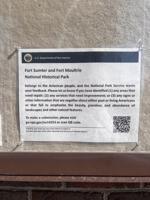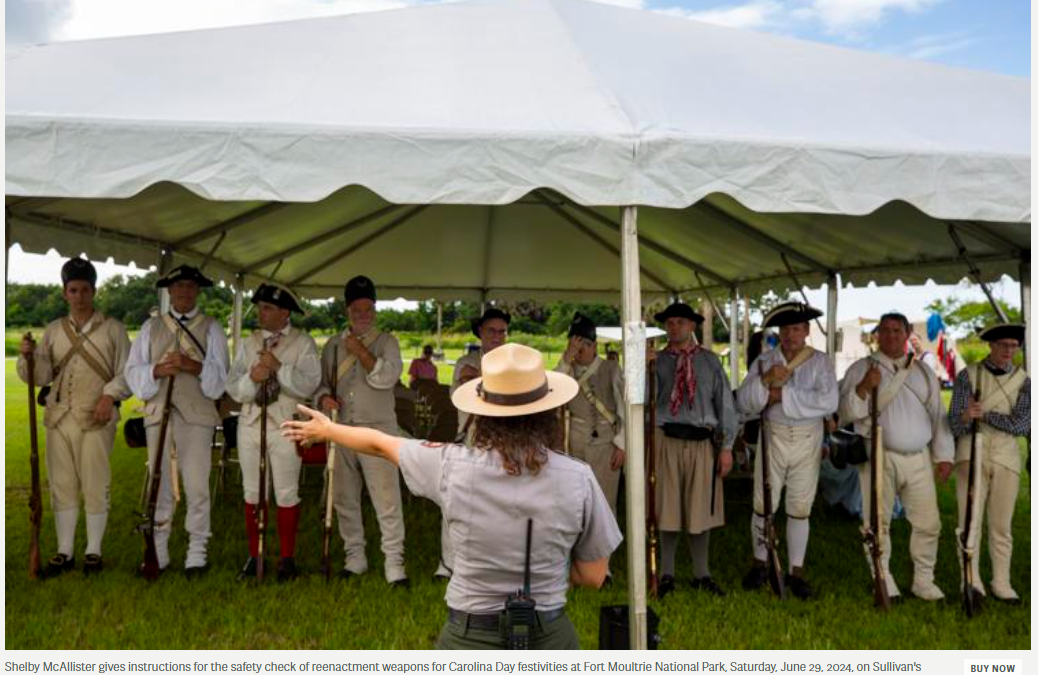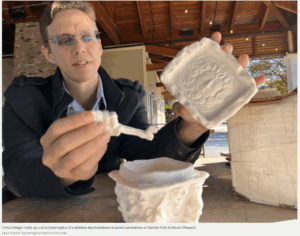SULLIVAN’S ISLAND — Some of the Confederate shots that started the Civil War were fired from here. And today, if you don’t like what you hear or see about the story you can report it for being negative about U.S. history.
In the past month, signs encouraging visitors to complete a feedback survey have recently popped up at National Park Service sites across the nation, including locally at Fort Sumter and Fort Moultrie.
Visitors are asked to report any areas of the sites that need improvement or repair, as well as any “signs or other information that are negative about either past or living Americans.”
That includes messaging that fails to “emphasize the beauty, grandeur, and abundance of landscapes and other natural features.”

At the Fort Sumter and Fort Moultrie visitors’ centers on Sullivan’s Island, the laminated sign is posted on a bulletin board by the entrance, and again next to the register where visitors purchase souvenirs and day passes.
An identical sign is posted at the Fort Sumter visitor center downtown overlooking Liberty Square on Concord Street.
The signs were part of a directive from Interior Secretary Doug Burgum. The May 20 order directed National Park Service staff to place signs on park properties soliciting feedback from visitors.
The goal outlined by Burgum in the order was to “restore Federal sites dedicated to history” to monuments that “remind Americans of our extraordinary heritage” and “unmatched record of advancing liberty, prosperity, and human flourishing.”
They also come in the wake of a nationwide effort by the Trump administration to scrub what the president deemed a “distorted narrative driven by ideology rather than truth” from national historic sites in a March 27 executive order titled “Restoring Truth and Sanity to American History.”
“This revisionist movement seeks to undermine the remarkable achievements of the United States by casting its founding principles and historical milestones in a negative light,” President Donald Trump wrote in the order.
It is unclear when exactly the signs were posted locally, and what, if any, action is taken in response to visitor feedback. Questions directed to NPS staff at Fort Sumter and Fort Moultrie were not answered in time for publication.
NPS spokesperson Rachel Pawlitz said in a statement to NPR that the order reaffirmed the mission of the National Park Service by “emphasizing the importance of accuracy in how we tell stories of American history.”
But the signs are sounding alarm bells for historians and parks advocates who see a censorship crackdown, where answers to questions about U.S. history may be delivered as whitewashed responses rather than researched interpretations out of fear of relating any part of history in a disparaging light.
The National Parks Conservation Association, a nonprofit advocacy and lobby group for the National Parks System, immediately decried the policies outlined in Burgum’s order. Trying to modify or erase pieces of history sets a dangerous precedent, Eboni Goddard, Southeast regional director for NPCA, said.
“It’s the opposite of what the National Park Service has stood for since it was founded,” Goddard said. “This is really an egregious attempt to sanitize history (and) censor dissenting viewpoints. It’s spreading misinformation in the hopes that a few — a select few — feel more comfortable with what they’re learning.”
The history of what happened in South Carolina and at Fort Sumter in the lead up to the Civil War is a controversial, multi-leveled and complicated story as a confederacy of Southern states exited the Union over slavery following the 1860 election of Abraham Lincoln. The rift culminated in cannon fire on April 12, 1861, as Confederate forces stationed in batteries around Charleston Harbor opened up on Maj. Robert Anderson’s U.S. troops inside Fort Sumter.
The event led to four years of bloody conflict.
On its Fort Sumter website, the park service does acknowledge that enslaved Black workers were brought into the fort to help shore up its defenses immediately following the rebel occupation. Six such enslaved people died at the fort in 1864 while 38 were wounded or hospitalized, according to the records.
“Enslaved African Americans worked as laborers, boat hands, bricklayers, carpenters, stone masons, and plasterers at Fort Sumter,” the park service website says.
Dr. Shannon Eaves, an associate history professor at the College of Charleston, teaches courses covering American history, slavery in the United States and Southern history, among other topics. She called the initiative to remove potentially offensive or negative information from historical sites disturbing.
“It’s an effort to censor historical narratives, to censor park staff and to just censor basic American history,” Eaves said. “It suggests that at no point in time did our country, did our leaders or did individuals do things that were harmful to other people.”
The potential removal of information is disheartening, and dangerous, she said, but it’s a phenomenon that the country has experienced before in the re-framing of the cause of the Civil War.
“Right here in South Carolina, for instance, for decades after the Civil War, many students got a narrative of Civil War and Reconstruction history that de-emphasized the role of slavery leading up to the Civil War,” Eaves said.
The story behind the present day site of Fort Moultrie goes back even before the Civil War. It was the previous location of Fort Sullivan during the American Revolution where the British were turned back on June 28, 1776.
From another chapter in U.S. history, Seminole Indian tribal leader Osceola, who waged war with the U.S. Army in Florida, is buried there too, succumbing to poor health as a prisoner in 1838, according to the park service.
Burgum’s directive gave a 90-day deadline for staff at national historical sites to review all public-facing monuments, memorials and markers to catalog anything inappropriate or that disparages any American, alive or dead, including those that lived in colonial times. That deadline expires on Aug. 18.
Thirty days after that deadline, or on Sept. 17, that content must be removed and replaced by content that focuses on American achievements and progress.
For anyone interested in responding to the park service, there is a QR code that leads to a website where visitors can submit their thoughts. According to the website, the information will be used to improve the “quality, accessibility and effectiveness of services provided within national parks.”
–postandcourier.com



